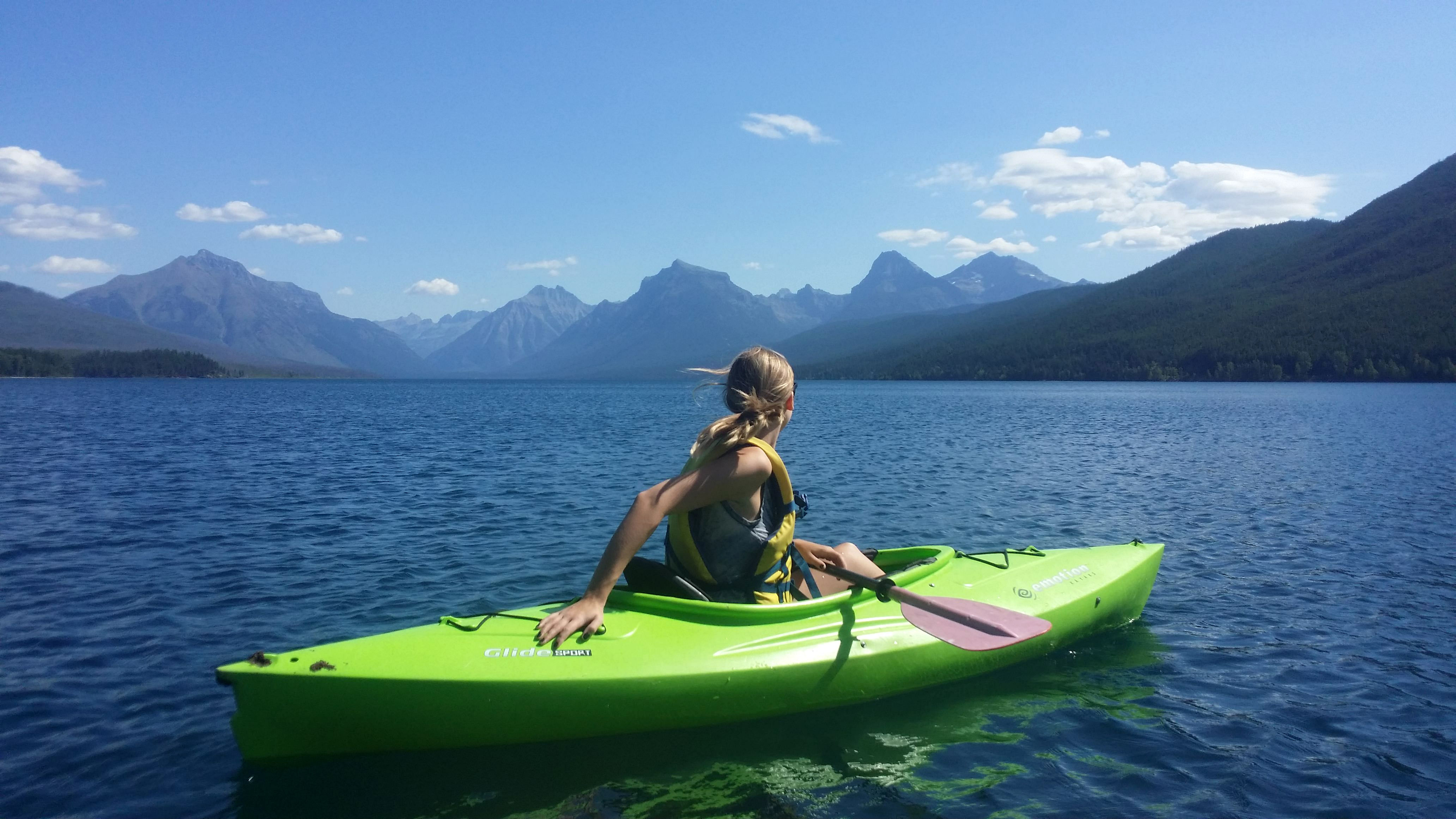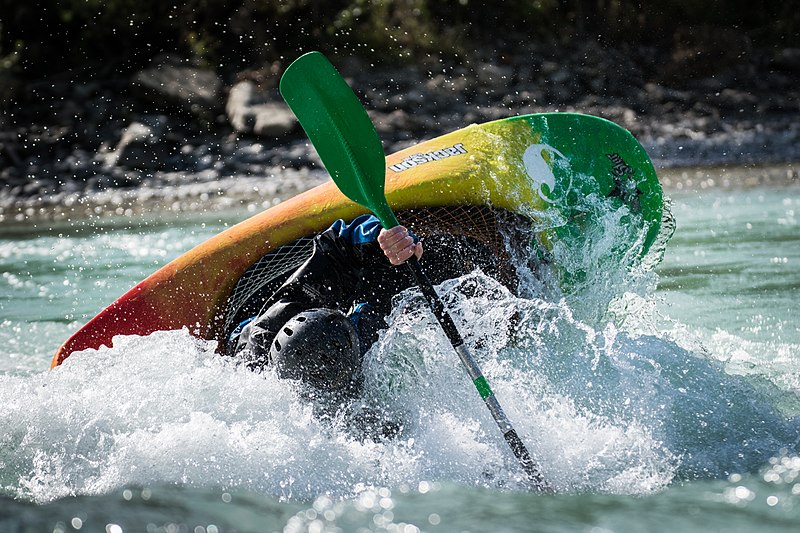Kayaking is a fun water sport that can be done in a kayak, a narrowboat with a double-blade paddle. The driver sits facing forward and moves the kayak through the water with alternating side-to-side paddle strokes.
Kayaking was invented for hunting and was used to hunt fish or transport passengers across the water. Later, it became a recreational sport or competitive event.
TYPES OF KAYAKING
Different kayaks are good for different types of water. So, there are various types of kayaking that let you enjoy nature in different ways.
1. Recreational Kayaking
A recreational kayak is designed for people who want to paddle for fun on a lake or flat water stream. They are currently the most popular type of kayak sold.
Compared to other big kayaks, recreational kayaks have a number of features, including a large cockpit that is easy to open and easy to get in and out of. It has a wide beam, about 70-75 cm (27-30 inches) wide, and usually less than 3.7 m (12 feet) long for better stability in the water. These smaller dimensions of recreational kayaks are smaller than long boats.
Compared to larger kayaks, recreational kayaks are lighter and easier to handle in and out of the water. This recreational kayak is inexpensive compared to larger kayaks. Recreational kayaks have wider hulls, so compared to longer and narrower models, recreational kayaks don't trace lines, especially straight lines. Recreational kayaks have limited payload capacity compared to giant kayaks.
The material used to manufacture recreational kayaks is rotomolded polyethylene, which is cheaper and less available. Recreational kayaks are commonly used for fishing. Other models may be inflatable, which makes them easier to store, but they must be inflated with an air pump once they are delivered to their intended destination.
2. Sea Kayaking or Touring
A sea kayak or touring kayak is a kayak designed for the sport of paddling in the open water of lakes, bays, and oceans.
Forms of sea kayaking
• Kayak sailing
Developed by kayak enthusiasts, kayak sails can complement or effectively eliminate the need for paddling. Using a sail allows for greater offshore range and longer expeditions. The use of sails for touring has a strong following among recreational sea kayakers, expedition paddlers and adventure racers.
• Expedition trips
Overnight camping weekend trips are popular with recreational kayakers, many combining kayaking and wildlife watching. Modern sea kayaks are designed to carry large amounts of gear and are used for unsupported expeditions of two weeks or more in environments from the tropics to the arctic. Expedition kayaks are designed for optimal handling when fully loaded, so ballast may be required for short trips.
• Surf kayaking
Closely related to surfboards and requiring skills in both surfing and kayaking, sea kayaks are specifically designed for the sport of surf kayaking.
• Kayak fishing
Sea kayaking has long been a means of transportation and access to fishing grounds, and the availability of dedicated stall structures has made kayak fishing popular. It also solves some of the ergonomic issues associated with the inability to move, and dedicated fishing kayaks are equipped with sporting accessories such as specially designed hatches, built-in rod holders, catch bags and gear.
Many of the techniques used in kayak fishing are the same as those used on other fishing boats. The difference is in the set-up, how each piece of equipment is fitted to the kayak, and how each activity is carried out on such a small craft. Contemporary kayaks can be equipped with fishing aids such as rod holders, electronic fish-finders and live-bait containers. Kayak anglers target highly prized bottom feeders like halibut and cod and also pelagics like amberjacks, tuna, sailfish, wahoo, and even marlin.
3. Whitewater kayaking
It`s an adventure sport where a river is navigated in a decked kayak. Whitewater kayaking includes several styles. River running; where the paddler follows a river and paddles rapids as they travel. Creeking usually involving smaller, steeper, and more technical waterways. Creek boats tend to be short but high volume to allow for manoeuvrability while maintaining buoyancy. Slalom requires paddlers to navigate through "gates" (coloured poles hanging above the river). Slalom is the only whitewater event to be in the Olympics. Play boating involves staying on one feature of the river and is more artistic than the others. Squirt boating uses low-volume boats (usually made specifically for the paddler) to perform special moves in whitewater features.
Types of whitewater kayaking
• River running
• Creeking
• Slalom
• Play boating
• Squirt boating
4. Surf kayaking
Surf kayaking is the sport, technique and equipment used in surfing ocean waves using a kayak. Surf kayaking has many similarities to surfboard surfing, but uses boats and paddles designed for use in surf zones. There are many kayak designs in use, all of which aim to use the waves to propel the boat.
surf kayaks are popular in many areas frequented by surfboard surfers. The sport has grown in popularity over the last few decades, keeping pace with the rise of sea kayaking and the latest materials and techniques.
5. Kayak fishing
Kayak fishing is fishing from a kayak. Kayaking has long been a means of transportation and a means of reaching fishing grounds. Kayak fishing is rapidly gaining popularity these days.• Kayak fishing technique
Many of the strategies utilized in kayak fishing are basically similar to the ones used on different fishing boats. The distinction is withinside the set-up, how every piece of system is suited to the kayak, and the way every interest is accomplished on this sort of small craft.
Contemporary kayaks may be ready with after-marketplace fishing add-ons which includes anchor trolleys, rod holders, digital fish-finders and live-bait containers. Kayak anglers goal incredibly prized gamefish like snook, pink drum, seatrout, tarpon, halibut and cod and additionally pelagics like amberjacks, tuna, sailfish, wahoo, king mackerel, or even marlin.
While backside fishing or jigging may be completed from small boats, it become lengthy idea that powerful trolling required speeds of 5 to 10 knots, a velocity nicely out of the variety of a person paddling. However, the invention that fish will be taken at a great deal lesser speeds has expanded the recognition of kayak fishing.
Another famous technique of fishing from kayaks which has emerged is that of softbaiting. This entails weighted jigheads and rubber or plastic gentle lures withinside the shapes of baitfish. This technique is the principal technique now used, especially withinside the Southern hemisphere, because it reduces the want to take messy livebaits on board the kayak.
Recently kayak fishing has began out to transport inland to freshwater lakes and rivers, in which anglers goal gamefish like largemouth bass, smallmouth bass, trout, muskellunge, and salmon.
Some of the main advantages of kayak fishing are the ease of use and transport, the affordable price of tackle compared to motorized boats, being an eco-friendly watercraft and providing fun and exercise.
6. Playboating
Special canoes and kayaks (boats) called playboats are often used, but any boat can be used. Movements and tricks often resemble those of snowboarders, surfers, or skaters where athletes twist, flip, spin, and more. Modern playboats allow the kayak and paddler to be completely airborne while performing tricks.The playing surface of the playboat is known as Freestyle His Kayak (formerly known as Rodeo).
What season is best for kayaking?
The best times for kayaking in most parts of the United States are late spring, early summer, and fall. Temperatures start to drop, but the water is still warm from the hot summer temperatures. The best time to kayak is from April/May to October.
Is it ok to kayak in wind?
In general, kayaking is safe in winds of less than 10 knots (about 11.5 mph), regardless of wind direction. The wind can be deceiving - offshore breezes make paddling difficult - especially on SUP boards.
Is it safe to kayak after rain?
The good news for individuals who like to kayak is that going kayaking in the rain is typically safe. That being said, there are a few dangers related to kayaking while the climate is wet outside. For one thing, there`s a more threat of thunder storms.
What shoes do you wear kayaking?
A water bootie or water shoe is the correct preference for kayaking. They will stay to your toes, maintain out the rocks, and your toes will stay heat at the same time as kayaking. Water sandals with right straps also are an amazing option, though you may have cold toes if the climate is cool.
Besides the kayak and paddle, here are a few things you should take with you every time:
• Sunscreen.
• Spare paddle.
• Appropriate clothing.
• Helmet or hat.
• Whistle or signaling device.
• Drybag with necessities.
• Water and snacks.
• Proper footwear.
What to do if you fall out of a kayak in a river?
If you fall out of your kayak, here are the steps to get back in:
1. Keep an eye on your paddle or it will drift away.
2. If the kayak is upside down, flip it over. To do this, stand in the middle of the boat. Reach up to the top of your torso (facing the sky), grab the ends, and fall back (pulling a rope or string helps). When backing up, the kayak will tip over again.
3. Attach the paddle to the boat.
4. Reposition your body in the middle of the kayak.
5. Grasp the front handle or the edge of the cockpit with one hand (depending on the kayak). With your other hand, grab the opposite handle or opposite lip of the kayak.
6. With a strong kick, pull your body vertically across the boat so your navel is above the cockpit/seat.
7. Roll and rotate your body, returning your buttocks to the kayak seat. At this point, you should be in the boat's side saddle.
8. Place your legs where you want them and bring your feet back to your feet.
9. If yours is a sit-in kayak, then use the bilge pump (that you in no way go away domestic without) to expel the extra waver over the lip of the cockpit wall.
10. Paddle away and inform your buddies you're at the back of due to the fact you desired a better have a take a observe a moose.
See also:- Standup paddleboarding, Wing foiling.




